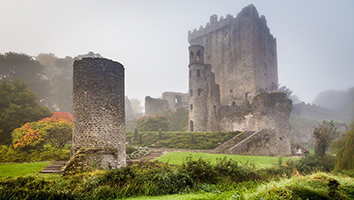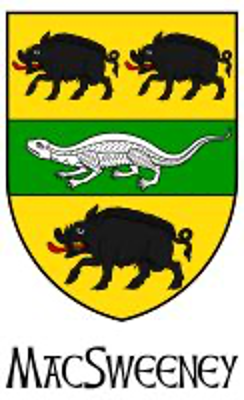https://www.johngrenham.com/findasurname.php?surname=MacSweeney
https://www.libraryireland.com/names/macs/mac-suibhne.php
https://en.wikipedia.org/wiki/McSweeney
Mac Suibhne- anglicised as MacSween(e)y, McSween(e)y, Swee(e)ny, MacSween, with up to 30 earlier variants, such as McSwiny, M’Sweeny & c. The root word is personal name Suibhne, which Woulfe states means “well-going”, q.v. “Sloinnte Gaedheal is Gall”, 1923.
There is also a Norse personal name Sveinn, meaning ‘boy’ or ‘servant’. Since the MacSweeneys were likely of mixed Gaelic-Norse descent, as many Galloglas (Norse-Gael mercenaries) were, this may well be relevant.
The Galloglaigh or Gallowglass foot soldiers were fierce, heavily armed fighting men, normally emanating from the Islands to the North and West of Scot-land. Of such were the MacDonnells / MacDonalds.
The MacSweeneys, probably crossing over from Argyle, arrived in County Donegal in the 14th century, according to most authorities, where they were hired by chiefs such as the O Donnell. However, they may well have been involved in Ireland before that date as Murrough MacSweeney’s death (hardly a natural one) is recorded in the Annals of Connacht in 1267: “Murchad MacSuibne was captured in the Owles by Domnall son of Magnus O Conchobair, and delivered up to Walter Burke, Earl of Ulster. He afterwards died in the Earl’s prison”.
MacFirbis’ “Genealogies” actually claims their descent from one Donnsléibe Ó Néill, who was a chieftain in Argyle, and whose son Suibne was the eponymous ancestor of the clan. This O Neill may or may not have been of the ‘race’ / tribe / clan of the Ulster O Neills. At any rate, MacSweeneys had, by the middle of the 14th century, set up septs / clans on the Irish model in Tyrconnel, County Donegal.
The three branches were known as Mac Suibhne Fánaid; Mac Suibhne Báinigh; and Mac Suibhne na dTuath. The first of these held Rathmullen Castle, and their kin spread into Kilmacrenan Barony. Banagh is the name of the barony, which includes the most westerly part of the Donegal coast, and MacSwines Bay. The last were lords of Tuathe Toraighe, including Tory Island.
It was a scion of the first mentioned above that migrated to Muscraighe (Muskerry) in County Cork in the early 1500s, where they soldiered for the MacCarthys. In Cork they held several castles, and were apparently famed for their hospitality. Captain Bryan MacSweeney, commander of Kilbrittane Castle, South Cork, is named as a commander of rebel militia in the 1641 ‘Depositions’, and accused of ordering the murder, or turning a blind eye to the murder of English Protestants.
By the time of the 1659 ‘Census’, an incomplete survey Ireland’s population by Cromwellian bureaucrat Sir William Petty, MacSweeney is described as a ‘Principal Irish Name’ in the following counties:
Donegal
Boylagh & Banagh (all specified here are baronies, unless otherwise stated), MacSwyne 7 (figures are for families); KillmacCrennan, MacSwyne 39.
Sligo
Leynie, McSwyne 7; Corenn, McSwyne 6
Mayo is missing from the ‘Census’.
Cork
City & Liberties, MacSwyny 8.
Tipperary
Eligurty & Ikerrin, Swyny 8.
Griffiths’ “Primary Valuation” of Irish households in the 1850s has the following:
Sweeny, Total No 1879; highest in counties Cork 544; Donegal 321; Mayo 204; Kerry 96; and Tipperary 89.
Sweeney, Total 640; highest in counties Donegal 145; Cork 145; Kerry 48.
McSweeny, Total 119; mostly Cork and Kerry;
McSwiney, 33, 25 of which in Cork city.
The 1890 births distribution figures (Matheson, ‘Special Report…’ 1894) show most Sween(e)y births occurring in counties Cork, Donegal, Mayo and Kerry.
Totals: Sweeney 166; Sweeny 82.
McSweeney had 29 occurrences, mostly in County Cork.
Two Famous Members of the Family:
Terence MacSwiney (1877-1920) the lord mayor of Cork whose 70 day hunger strike sent reverberations around the world. His death as a martyr for Irish independence perhaps sounded the death knell of British rule in all Ireland.
Thomas William Sweeney (1820-1892) born in Cork, went to the U.S. where he enlisted as a soldier; he finished up as a brigadier general. In the Civil War he gained notoriety by answering the call to surrender the arsenal at St Louis (to Confederate forces) that he would rather blow it up. His strong character showed up again in his agreeing to lead the Fenian raid into Canada in 1866.
It seems there is not an active clan organisation for your name, at this time.
However, the revival of interest in Irish culture and heritage over the past 100 years has led to the revival of many Irish Clans. In more recent times, increased access to historical archives online, DNA testing and ease of travel to Ireland has led many individuals to explore their own genealogy and connections to Irish Clans. Some of these have gone on to establish Clan Associations in Ireland, the USA, the UK, Canada, Australia, New Zealand and anywhere that the Irish Diaspora has found itself.
Clans of Ireland Ltd invite those interested in Irish Clans to contact them with a view to explore the possibility of reviving your Irish Clan.

